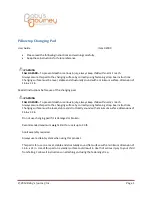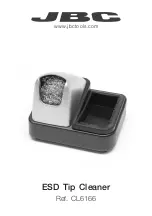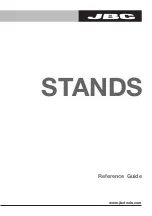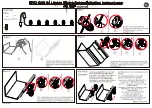
31
To return the blinking display to normal:
1. The display will return to normal when the supply air
temperature returns to within the limits of the current sys-
tem operating mode. Refer to the System Time Guards
section on page 17 for more information.
2. If the TEMP system thermostat does not utilize a DX coil
sensor, but the DX Coil Temperature Sensor option has
been configured to ON, the annunciator will blink. Re-
configure the DX Coil Sensor option.
3. Check the TEMP system thermostat supply-air tempera-
ture sensor or DX coil temperature sensor to see if the
sensor is wired incorrectly or defective.
Equipment Operation Problems —
The TEMP sys-
tem thermostat is designed to energize constant volume heat-
ing and cooling equipment to satisfy the system comfort
requirements.
When the TEMP system thermostat fails to pick a system
mode, or fails to energize the heating or cooling equipment
when expected, the problem usually involves the configurable
options of the TEMP system thermostat.
If the TEMP system thermostat selects a system mode, but
the heating or cooling equipment fails to energize, the problem
may be with the relay pack.
TEMP SYSTEM THERMOSTAT FAILS TO SELECT SYS-
TEM MODE — When the TEMP system thermostat fails to
select a system mode, check the items that influence the TEMP
system thermostat to select system mode.
1. The zone must be 1.5° F or more from set point.
2. The TEMPsystem thermostat system switches (FAN,
COOL, HEAT) must be set to AUTO or ON to operate.
3. Ensure that the TEMP system thermostat Heating and
Cooling Time Guard has had time to expire. If the Time
Guard Between Modes option (category 4, option 2) has
been configured ON, the system will not operate until
time guard has expired. Time guard delay occurs after
power up, reset, or system mode has been released.
Length of the time guard is (2.6 seconds x TEMP system
thermostat device address) + 5 minutes.
If the Time Guard Between Modes option is configured
OFF, the length of the time guard is approximately
1.5 minutes.
The Time Guard Override option may be used to override
the time guard to 30 seconds for one cycle. To activate the
override, toggle category 4, option 3, ON and then OFF.
4. Check the configuration of the TEMP system thermostat
System Heating Mode Lockout, Heating Lockout Tem-
perature Set Point, and Cooling Lockout Temperature Set
Point options. Based on the outside-air temperature, the
TEMP system thermostat can lock out either system cool-
ing or heating modes.
TEMP SYSTEM THERMOSTAT FAILS TO ENERGIZE
SECOND STAGE — When the TEMP system thermostat fails
to energize the second stage of the heating or cooling equip-
ment, check the items that affect the decision of the TEMP
system thermostat to energize the second stage of heating or
cooling.
1. When a system mode is selected and the reference zone
demand is equal to or greater than 8° F, the TEMP system
thermostat Energy Saver Lockout function automatically
disables the second stage operation of the unit for approx-
imately 20 minutes. This function saves energy by allow-
ing the first stage of the heating or cooling unit to satisfy
the system load at times of low thermal load (morning
cool down or warm up).
2. When the TEMP system thermostat Comfort Trend Stag-
ing function (category 7, options 4 and 5) is configured to
a value other than zero, the TEMP system thermostat will
energize the second stage of heating or cooling only after
it determines that the reference zone demand is not being
met by the first stage of heating or cooling.
If the Comfort Trend Staging function is configured off,
the TEMP system thermostat will energize the second
stage 3 minutes after the first stage, if the demand of the
reference zone is equal to or greater than 2° F.
3. Check the TEMP system thermostat display for a flash-
ing HEAT or COOL annunciator. A blinking annunciator
indicates a supply-air temperature problem.
ANNUNCIATOR DISPLAYED BUT EQUIPMENT NOT
ENERGIZED — The TEMP system thermostat HEAT or
COOL annunciator is ON, but the heating or cooling equip-
ment is not energized.
Check the TEMP system thermostat Auxiliary Relay option
(category 4, option 9). If the TEMP system thermostat is con-
figured to operate an economizer, the TEMP system thermostat
will enable the economizer for first stage cooling when the out-
side-air temperature is less than 64.9 F.
Check the LEDs on the relay pack controlled by the TEMP
system thermostat. Perform the correct procedure.
LED Not Lit — The TEMP system thermostat HEAT or
COOL annunciator is ON but the LED on the relay pack is not
lit. With the relay pack plugged in, check the voltages across
the relay pack input connector plug. Voltages should read ap-
proximately 4 to 6 vdc (steady) between the black wire and the
appropriate relay pack input wire. If not, replace relay pack.
LED Is Lit — The TEMP system thermostat HEAT annuncia-
tor is ON, the LED on the relay pack is lit, but the correspond-
ing equipment stage is not energized.
1. Check the AC voltage across the relay board common
(red) and any deenergized relay (H1 or C1). The voltage
should read 24 vac. If not, check for wiring error.
2. Check the AC voltage across the relay board common
(red) and any indicated energized relay board output
(FAN). The voltage should read near zero (<1 vac). If 24
vac is read, check for bad relay board.
3. Check the AC voltage across a suspected contactor coil.
The voltage should read 24 vac. If not, check the contac-
tor coil wiring.
4. Other possibilities are: bad contactor, defective equip-
ment, or no unit power.


































